


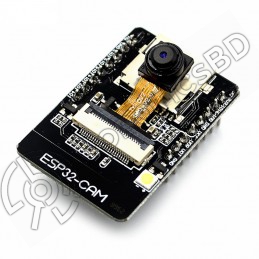

Programmer: ESP32-CAM-MB MICRO USB Download Module
|
The ESP32 CAM does not come pre-assembled with the camera. You'll need to connect the camera ribbon cable to the board, a task which can be somewhat challenging. It's essential to ensure proper connection, as the camera will not function otherwise. Forceful insertion can damage both the camera and the connector. We recommend using tweezers for precision and urge you to exercise patience during this process. |
 Store Pickup Available!
Store Pickup Available!
 Free Ship Over 5000 BDT
Free Ship Over 5000 BDT
 Quality Product
Quality Product
 No Warranty
No Warranty
 No Replacement
No Replacement
The ESP32 CAM WiFi Module Bluetooth with OV2640 Camera Module 2MP For Face Recognization has a very competitive small-size camera module that can operate independently as a minimum system with a footprint of only 40 x 27 mm; a deep sleep current of up to 6mA and is widely used in various IoT applications. RoboticsBD
It is suitable for home smart devices, industrial wireless control, wireless monitoring, and other IoT applications.
This module adopts a DIP package and can be directly inserted into the backplane to realize rapid production of products, providing customers with high-reliability connection mode, which is convenient for application in various IoT hardware terminals. RoboticsBD
ESP integrates WiFi, traditional Bluetooth, and BLE Beacon, with 2 high-performance 32-bit LX6 CPUs, 7-stage pipeline architecture. It has the main frequency adjustment range of 80MHz to 240MHz, on-chip sensor, Hall sensor, temperature sensor, etc. Featured By RoboticsBD.
Product Images are shown for illustrative purposes only and may differ from the actual product.
RoboticsBD RoboticsBD RoboticsBD RoboticsBD RoboticsBD RoboticsBD RoboticsBD RoboticsBD RoboticsBD RoboticsBD
|
The ESP32 CAM does not come pre-assembled with the camera. You'll need to connect the camera ribbon cable to the board, a task which can be somewhat challenging. It's essential to ensure proper connection, as the camera will not function otherwise. Forceful insertion can damage both the camera and the connector. We recommend using tweezers for precision and urge you to exercise patience during this process. |
Launch the Arduino IDE and navigate to File > Preferences.
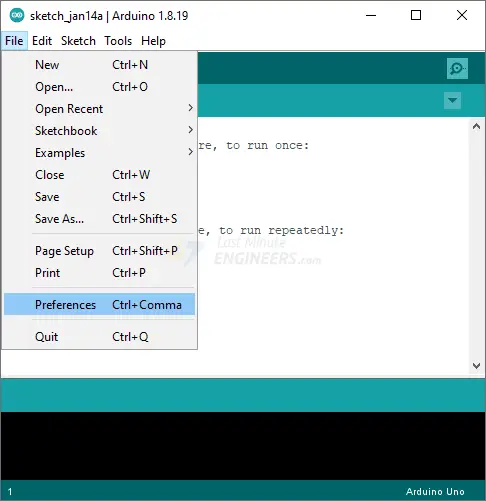
Fill in the “Additional Board Manager URLs” field with the following.
https://raw.githubusercontent.com/espressif/arduino-esp32/gh-pages/package_esp32_index.jsonThen, click the “OK” button.
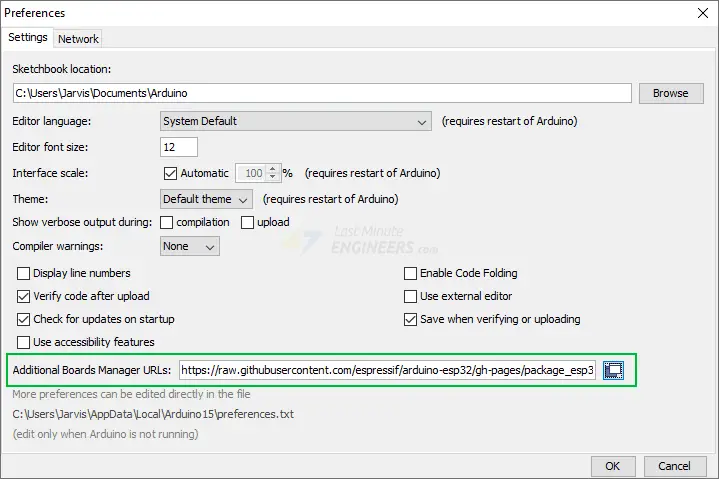
If you have already entered the URL for the ESP8266 boards or any other board, you can click on the icon to the right of the field to open a window where you can add additional URLs, one for each row.
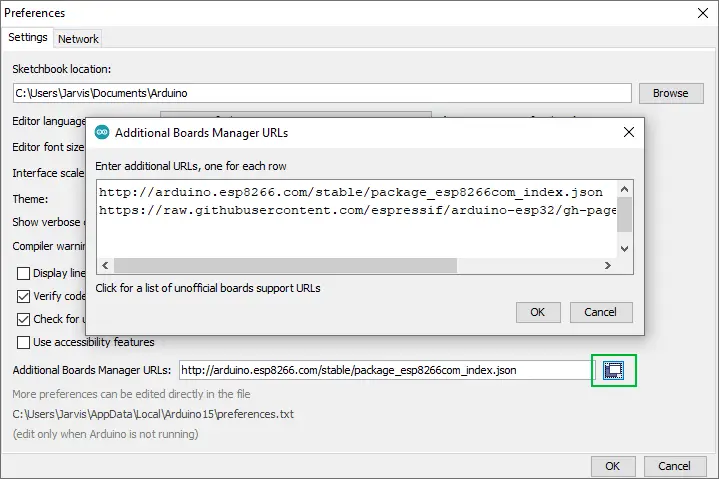
Now navigate to Tools > Board > Boards Manager…

Filter your search by entering ‘esp32‘. Look for ESP32 by Espressif Systems. Click on that entry, and then choose Install.

After installing the ESP32 Arduino Core, restart your Arduino IDE and navigate to Tools > Board > ESP32 Arduino and select AI-Thinker ESP32-CAM.
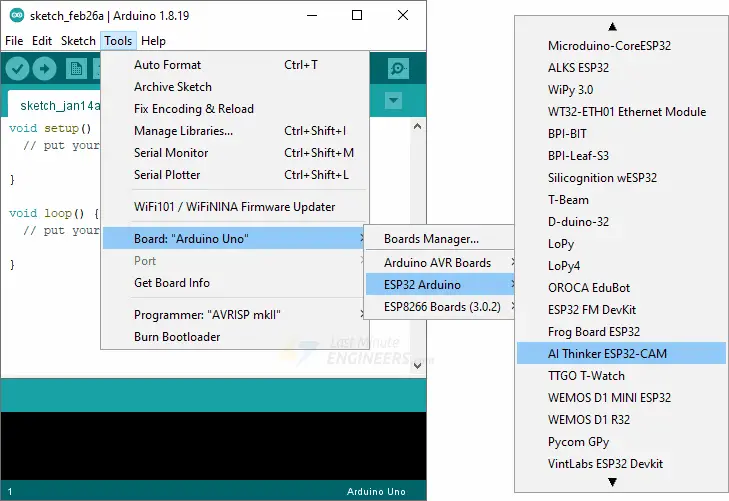
Now connect the ESP32-CAM to your computer using a USB cable. Then, navigate to Tools > Port and choose the COM port to which the ESP32-CAM is connected.
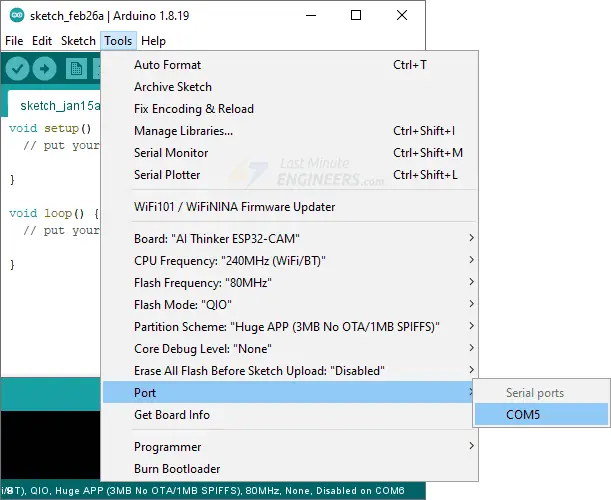
That’s it; the Arduino IDE is now set up for the ESP32-CAM!
Let’s try running the CameraWebServer sketch. This sketch transforms the ESP32-CAM into a full-featured webcam, complete with features like face detection and a ton of customization options. This is a very impressive example of what the ESP32-CAM can do!
You can find this example under File > Examples > ESP32 > Camera > CameraWebServer.
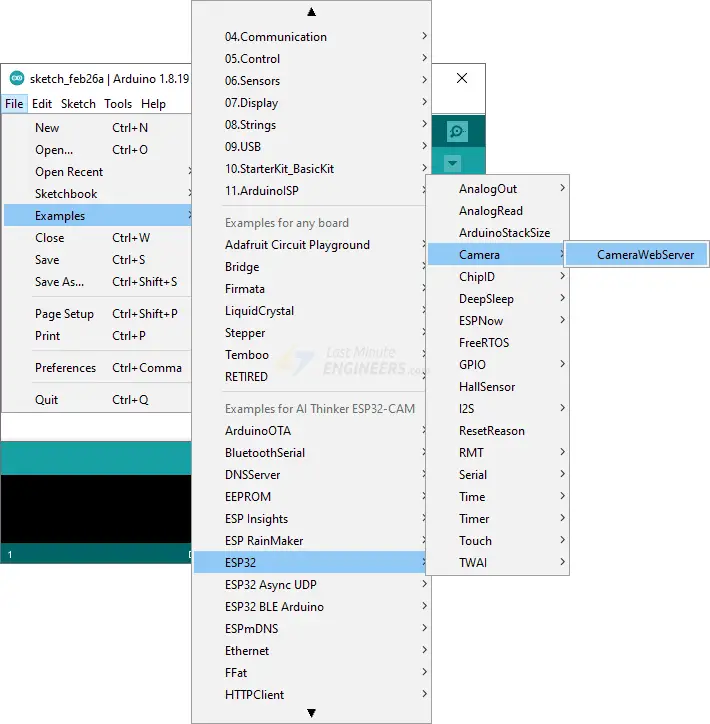
We’ll need to make a few changes to get this to work with your ESP32-CAM.
You must choose the appropriate camera model. Because we’re using the AI-THINKER model here, uncomment it and comment all the other models.
// ===================
// Select camera model
// ===================
//#define CAMERA_MODEL_WROVER_KIT // Has PSRAM
//#define CAMERA_MODEL_ESP_EYE // Has PSRAM
//#define CAMERA_MODEL_ESP32S3_EYE // Has PSRAM
//#define CAMERA_MODEL_M5STACK_PSRAM // Has PSRAM
//#define CAMERA_MODEL_M5STACK_V2_PSRAM // M5Camera version B Has PSRAM
//#define CAMERA_MODEL_M5STACK_WIDE // Has PSRAM
//#define CAMERA_MODEL_M5STACK_ESP32CAM // No PSRAM
//#define CAMERA_MODEL_M5STACK_UNITCAM // No PSRAM
#define CAMERA_MODEL_AI_THINKER // Has PSRAM
//#define CAMERA_MODEL_TTGO_T_JOURNAL // No PSRAM
// ** Espressif Internal Boards **
//#define CAMERA_MODEL_ESP32_CAM_BOARD
//#define CAMERA_MODEL_ESP32S2_CAM_BOARD
//#define CAMERA_MODEL_ESP32S3_CAM_LCDNext, you need to tell the ESP32-CAM about your wireless network. Fill in the following variables with your network credentials:
const char* ssid = "REPLACE_WITH_YOUR_SSID";
const char* password = "REPLACE_WITH_YOUR_PASSWORD";The code that needs to be modified is highlighted in yellow.
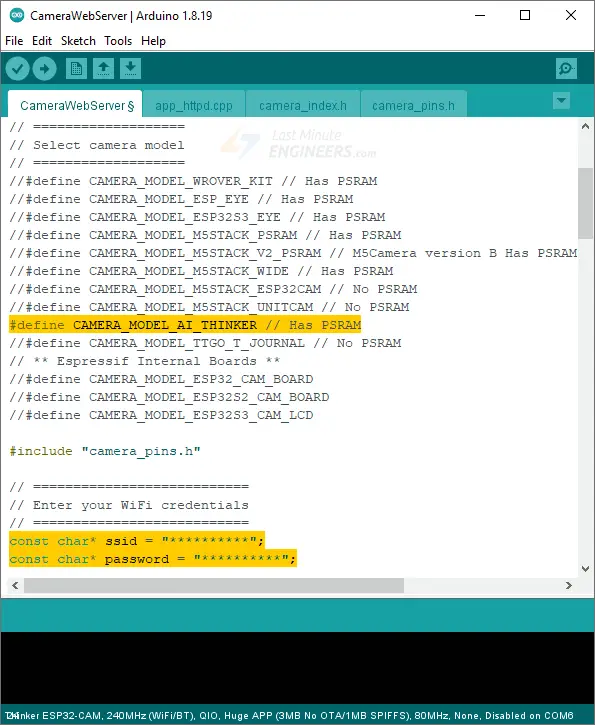
The code is now ready to be uploaded to the ESP32-CAM.
Once you have uploaded the sketch, open the serial monitor at baud rate 115200 and press the Reset button on the ESP32-CAM. You should see the IP address in the Serial Monitor.
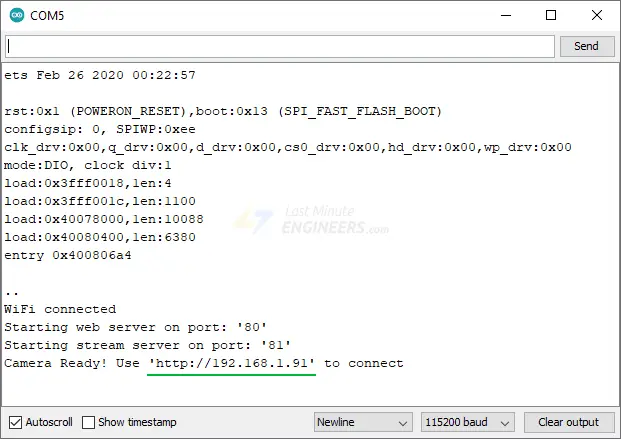
Launch a browser and enter the IP address shown on the serial monitor. Ensure that the web browser is on the same network that the ESP32-CAM is connected to.
The ESP32-CAM should display a web page. To begin video streaming, press the Start Stream button.
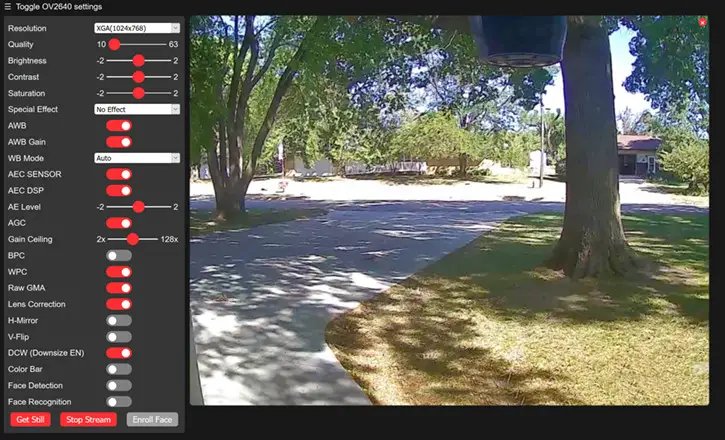
You can play around with various camera settings in the left pane. For instance, you can alter the video’s resolution and frame rate, as well as its brightness, contrast, saturation, and the like.
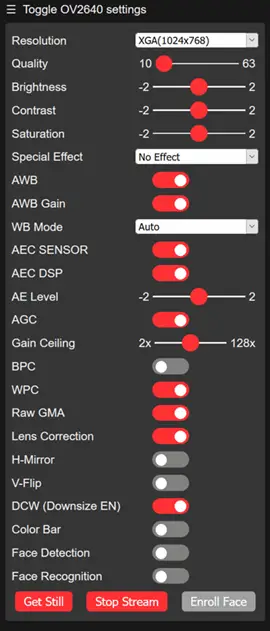
Simply hit the Get Still button to take a picture. Note that images are downloaded to the computer rather than being saved to the microSD card.
ESP32-CAM :
Specifications :
1 x ESP32 CAM WiFi Module.
1 x OV2640 Camera Module 2MP.
RoboticsBD RoboticsBD RoboticsBD RoboticsBD RoboticsBD RoboticsBD RoboticsBD RoboticsBD RoboticsBD RoboticsBD
RoboticsBD RoboticsBD RoboticsBD RoboticsBD RoboticsBD RoboticsBD RoboticsBD RoboticsBD RoboticsBD RoboticsBD
The latest price of ESP32-CAM WiFi + Bluetooth Camera Module Development Board ESP32 With Camera Module OV2640 in Bangladesh is BDT 848 You can buy the ESP32-CAM WiFi + Bluetooth Camera Module Development Board ESP32 With Camera Module OV2640 at best price from our RoboticsBD or visit RoboticsBD Office.
|
Please note that the product information provided on our website may not be entirely accurate as it is collected from various sources on the web. While we strive to provide the most up-to-date information possible, we cannot guarantee its accuracy. We recommend that you always read the product labels, warnings, and directions before using any product. |
|
Product Images are shown for illustrative purposes only and may differ from the actual product. |










































Reference: RBD-1852
IPEX To SMA Female External Antenna Adapter SMA Male Antenna for 2.4G WIFI Module Only Antenna and Adapter RF Cable ESP32 Cam is not included
Reference: RBD-1976
High sensitivity for Low-Light Operation. Low Operating Voltage for Embedded Portable Apps. Supports Scaling. The Standard SCCB Interface is Compatible with the I2C Interface.
Reference: RBD-2044
Model: ESP32-CAM-MB Color: Black Chipset: CH340G Connectivity Technology: USB Note: The camera module is not included with the board.
Reference: RBD-0136
Microcontroller: AT91SAM3X8E Operating Voltage: 3.3V Input Voltage (recommended): 7-12V Input Voltage (limits): 6-16V Digital I/O Pins: 54 (of which 12 provide PWM output) Analog Input Pins: 12 Analog Outputs Pins: 2 (DAC) A 32-bit core, that allows operations on 4 bytes wide data within a single CPU clock. CPU clock at 84Mhz 96KBytes of SRAM
Reference: RBD-1603
USB-TTL converter. Logic Level: 5V. Operating Supply Voltage: 5V. Digital I/O Pins: 14. Analog I/O Pins: 6.
Reference: RBD-0094
The Arduino Uno R3 High-Quality Edition Arduino UNO in Bangladesh Micro-controller : ATmega328. Operating Voltage : 5V. Input Voltage (recommended) : 7-12V. Digital I/O Pins : 14 (of which 6 provide PWM output). Analog Input Pins : 6. The Arduino Uno R3 High-Quality Edition embodies superior craftsmanship and meticulous attention to detail, resulting in...
Reference: RBD-1133
Compatible with NUCLEO-F411RE, onboard Cortex-M4 microcontroller STM32F411RET6 Arduino connectivity support, easy to connect with various Arduino shields and access the massive Arduino resources ST Morpho headers provide full access to all STM32 I/Os, easy for peripheral expansion Supports mbed, build prototype quickly by mbed SDK and online tools...
Reference: RBD-1255
Integrated 0.96″ OLED Micro USB connection Compatible with Arduino Compatible with NodeMCU(Lua for ESP8266) Input Power 5V Compatible for Arduino Compatible with NodeMCU(Lua for ESP8266)A high-quality USB cable is essential for this board to ensure sufficient current supply; otherwise, your board may not be recognized by the Windows Device Manager. Please...
Reference: RBD-1807
Altera Cyclone IV FPGA EP4CE6E22C8N EP4CE6 Development Board
Reference: RBD-2053
ATMEGA32U4 running in 5V / 16MHz Support Arduino IDE V1.0.1 Micro USB interface programming on the board Four 10-bit ADC pin 12 digital I / O (5 PWM capability) Rx and Tx hardware serial connection. RoboticsBD
Reference: RBD-1214
The board is compatible with Mega 2560. excellent solution for developing projects based on ATmega2560. The board can be powered directly through the Micro USB connector The maximum output current upon 5V is around 800mA, while on the 3.3V it is about 800mA.
Reference: RBD-2162
USB Type: Type-A to Mini-B Length: 1 meter/ 3.2 Feet Exclusively designed for Arduino boards. Compatible with Arduino Nano Larger Cable
Reference: RBD-2266
Versatile and powerful development board for IoT and embedded systems projects. USB Type-C port for reversible plug orientation and easy connection to computer or other devices. Built-in Wi-Fi and Bluetooth module for wireless connectivity. Arduino IDE compatibility for easy code writing and uploading. Suitable for a wide range of applications, including...
Reference: RBD-1218
Model No.:NX8048T050 Display Type:011R(R:Resitive Touchscreen) Operating Voltage (VDC):4.75 ~ 7 Max. Operating Current (mA):410 Touch Type: Resistive Colors:65K (65536)
Reference: RBD-2241
Wearable e-textile technology. Designed with large sew tabs LED White Color
Reference: RBD-1216
14-/20-pin DIP (N) Socket 20 pin LaunchPad standard leveraging the BoosterPack ecosystem On-Board EZ-FET emulator featuring EnergyTrace™ technology Supports MSP430G2xx2, MSP430G2xx3, and MSP430F20xx devices in PDIP14 or PDIP20 packages 1 user buttons and 3 LEDs for user interaction
Reference: RBD-1827
Altera Cyclone IV EP4CE6 FPGA Development Board NIOSII EP4CE PCB USB Blaster Jtag AS Programmer
Reference: RBD-2137
ESP32 Development Board Integrated antenna and RF balun Dual-mode Wi-Fi and Bluetooth chips Small size and high performance-price ratio Compatible with Arduino
Reference: RBD-2199
Compatible with the Arduino IDE, making it easy for beginners to start using Smaller and cheaper than traditional Arduino boards Powered by a 16.0 MHz microcontroller Fully assembled except for headers, allowing for easy soldering Great for projects where size and cost are a concern Perfect for beginners to jump into electronics Can be used for a variety...
Reference: RBD-2271
Wide compatibility with ESP32-DevKitC(30P) series boards Safe and reliable with stable power and signal transmission Extended GVS interface for easy connection to various electronic modules and sensors JUMP interface for easy reuse of all pins, making it ideal for DIY projects Versatile and reliable option suitable for a wide range of projects
Reference: RBD-1602
Microcontroller: ESP8266EX Operating Voltage: 3.3V Digital I/O Pins: 11 (all I/O pins have interrupt/PWM/I2C/one-wire capability, except for D0) Analog Input Pins: 1 Flash Memory: 4MB On-Board Switching Power Supply: Input Voltage Range: 9V to 12V Output: 5V at 1A Max
Reference: RBD-1684
8 Channel DC 12V Pro mini Relay Shield Module PLC Timer Board for Arduino
Reference: RBD-1527
Based on ATmega32 8 Bit microcontroller USB external programmer Included Datasheet, Manual, Software & Sample codes All Port pins pins available for peripheral interfacing
Reference: RBD-1131
Up to 480 Mbps data transfer rate. USB Type: Type-A to Mini-B Weight: 15 gm Length: 30 cm Exclusively designed for Arduino boards.
Reference: RBD-1761
USB Type: Type-A to Type-B Weight: 80 gm. Length: 1m / 3.2Feet Long cable for easy work Fully compatible with the PC. Molded strain relief and PVC over-molding to ensure a lifetime of error-free data transmissions.
Reference: RBD-1215
131 powerful instructions – Most Single Clock Cycle Execution 32 x 8 general purpose working registers Fully static operation Up to 20MIPS throughput at 20MHz On-chip 2-cycle multiplier Write/erase cycles: 10,000 flash/100,000 EEPROM Optional boot code section with independent lock bits In system programming by on-chip boot program True read while write...
Reference: RBD-2239
Wearable e-textile technology. Designed with large sew tabs LED Red Color
Reference: RBD-2244
Wearable e-textile technology. Designed with large sew tabs Slide Switch
Reference: RBD-2126
Manufacturer: China Support TWI and SPI communication Input voltage (recommended) range from 7V to 12V Input Voltage (limit) range from 6V to 20V 20 digital input/output pins (of which 7 can be used as PWM outputs and 12 as analog inputs) Onboard ATmega32u4 microcontroller with 32KB flash memory, 2.5KB SRAM and 1KB EEPROM
Reference: RBD-2270
Powerful and versatile ESP32 SoC with WiFi and Bluetooth connectivity 4MB of flash memory and 520KB of SRAM for storing firmware and data Compatible with the Arduino development environment for easy programming Input/output pins for connecting to sensors, actuators, and other peripherals Can be programmed using MicroPython, a high-level programming...
Reference: RBD-2160
Fully compatible with the PC. Moulded strain relief and PVC over moulding to ensure a lifetime of error-free data transmissions. Aluminium under mould shield helps meet FCC requirements on KMI/RFI interference. Foil and braid shield complies with fully rated cable specifications reducing EMI/FRI interference.
Reference: RBD-1821
Open-source, Interactive, Programmable, Low cost, Simple, Smart, WI-FI enabled Arduino-like hardware IO Integrated TR switch, balun, LNA, power amplifier and matching network Integrated PLL, regulators, DCXO and power management units Onboard USB to serial chip to easily program and upload codes from the Arduino IDE Easy to use breadboard friendly form...
Reference: RBD-2242
Wearable e-textile technology. Designed with large sew tabs LED Yellow Color
Reference: RBD-0034
Weight: 55g Dimension: 40.7×19.7×42.9mm Stall torque: 9.4kg/cm (4.8v); 11kg/cm (6.0v) Operating speed: 0.19sec/60degree (4.8v); 0.15sec/60degree (6.0v) Operating voltage: 4.8 ~ 6.6V Gear Type: Metal gear Dead band width: 1us Wire length: 32cm
Reference: RBD-1820
38 Pin version 2.4GHz Dual-Mode WiFi + Bluetooth Development Board, 38PIN Ultra-Low power consumption works perfectly with the IDE A high-quality USB cable is essential for this board to ensure sufficient current supply; otherwise, your board may not be recognized by the Windows Device Manager. Please avoid using mobile phone cables and instead use the...
Reference: RBD-1162
Net Content: 15g Paste Color: Brown Does not create High Smoke Does not create Foul/Bad Smell No Residual Waste High-Quality Soldering Additives & Activators for effective soldering Useful for general purpose soldering, electrical wires, components, and cables etc
Reference: RBD-0836
Model: 14500 Type: Li-Ion Battery Mark Capacity: 850mah Nominal Voltage: 3.7v Color: Blue Weight: 17g Rechargeable Battery: Yes Note: It's a clone battery so the ampere couldn't be guaranteed.
Reference: RBD-0278
Model: MG995 Weight: 55 gm Operating voltage: 4.8V~ 7.2V Servo Plug: JR Stall torque @4.8V : 10 kg-cm Stall torque @6.6V : 12 kg-cm
Reference: RBD-2105
40P color jumper wires Length: 300mm Weight: 45 gm Compatible with 2.54mm spacing pin headers High quality and in good working condition Durable and reusable Easy to install and use
Reference: RBD-0702
It has a relay status indicator led Power LED(Green), 8 relay status indicator LED(Red) Relay control interface by single-chip IO. Low-level suction close, high-level release. Easy to use, simple 3 line structure. Note: Relay might be different from the picture as per stock